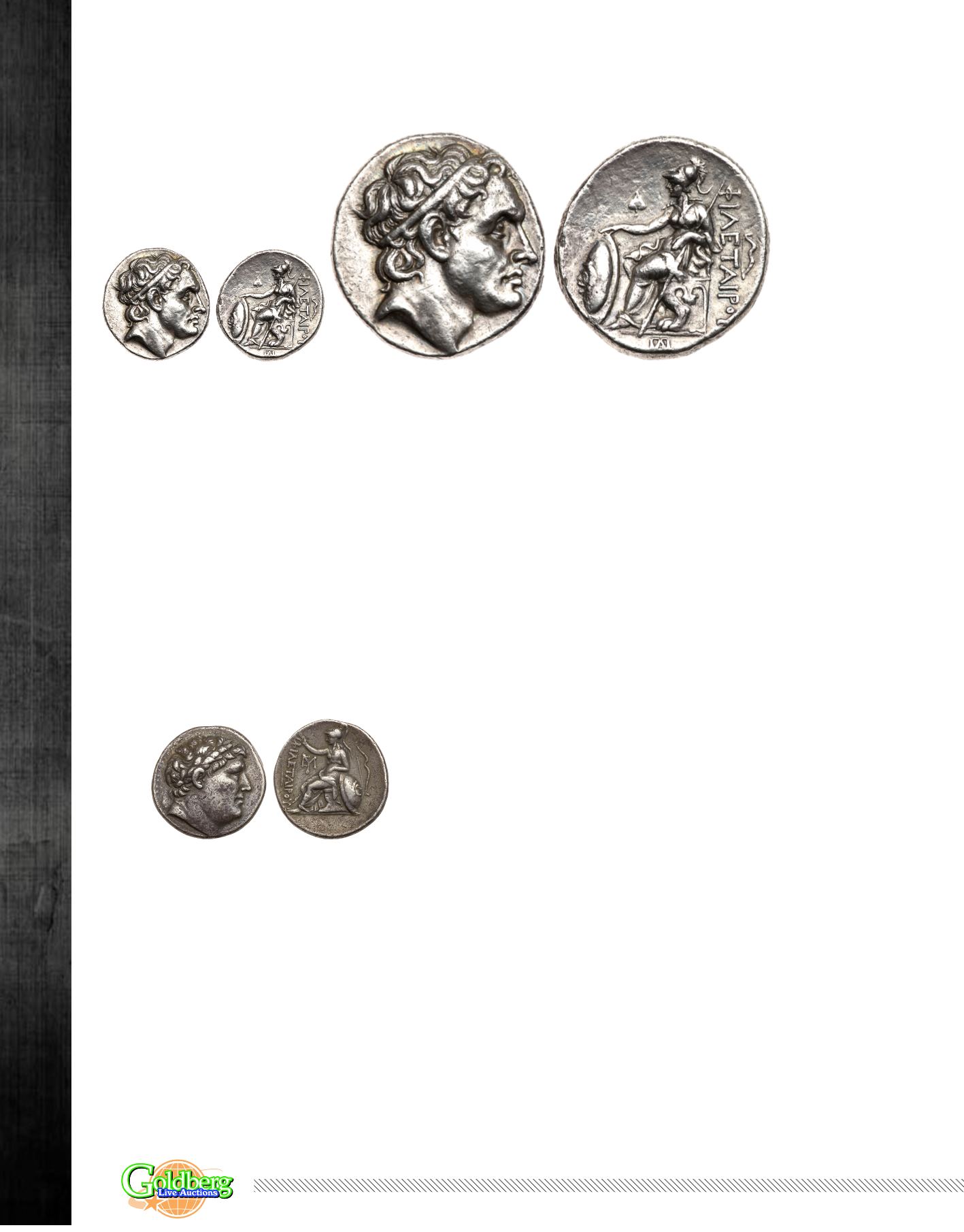

81
|
Session Five - Tuesday, February 14th 10:00am PST
T
HE
I
CONIC
P
OWERFUL
P
ORTRAIT
T
ETRADRACHM OF
S
ELEUKOS
I
Enlargement
1698 Pergamene Kingdom. Philetairos. Silver Tetradrachm (16.74 g), 282-263 BC
. Ca. 269/8-263 BC. Diademed head of Seleukos I right.
Reverse:
, Athena seated left, supporting shield set on ground before her, spear cradled in arm and resting elbow on small statue of
sphinx; in upper left field, ivy leaf; in outer right field, bow; in exergue,
monogram. Ingvaldsen 6c (dies III/13; this coin); Newell 13; SC
309.4b; SNG BN 1602 (same obv. die). Amazing Hellenistic portrait! Fine high relief style and lightly toned.
Extremely Fine
.
Estimate Value ......................................................................................................................................................................... $10,000 - UP
The Hanbery Collection; Purchased privately from CNG in 1990. Ex Leu 38 (13 May 1986), 102; Ex Hirsch XXXI (6 May 1912), 447.
The obverse portrait of this coin should be familiar to anyone who has ever looked up a coin in Arthur Houghton and Catherine Lorber' s
Seleucid
Coins: A Comprehensive Catalogue, Part 1,
since it is the same image of Seleukos I Nikator, the founder of the Seleukid Empire, that appears on
the dust jacket. Ironically, as anyone who has read the sale description of this coin will know, the coin is not actually a Seleukid royal issue, but
rather an issue of Philetairos, the powerful dynast of Pergamon as a sign of his (opportunistic) loyalty to the Seleukos after the fall of his chief
rival,
Lysimachos.In301 BC, Alexander the Great' s successor, Lysimachos, placed Philetairos in command of the fortress at Pergamon and its trea-
sury of 9,000 talents of silver. Despite being derided as a eunuch from the small town of Tieion in Pontos, Philetairos was politically very savvy.
When plotting within the family of Lysimachos caused him to execute his widely respected son, Agathokles, in 281 BC, Philetairos used the situa-
tion to raise a revolt in Western Asia Minor and invited Seleukos I to be the real muscle of the rebellion and take over Lysimachos' possessions
once he was defeated. Events played out just as the commander of Pergamon had hoped and Lysimachos was defeated and killed at the Battle of
Koroupedion, leaving Seleukos I the new master of western Asia Minor.Philetairos' tetradrachm here honors the victor of Koroupedion with an
evocative diademed portrait - the earliest completely indisputable image of Seleukos I - but retains the old Athena Nikephoros reverse that had
been popularized by the coinages of Lysimachos. However, the goddess no longer crowns the name of the dead king, but rather that of Philetai-
ros.Asit turned out, things went even better for Philetairos than he had planned. A year after the fall of Lysimachos, Seleukos I was dead at the
hands of the murderous Ptolemy Keraunos and the Seleukid Empire was beginning to show signs of disintegration. All of this turmoil allowed Phile-
tairos to consolidate his power locally and plant the firm foundation for the Attalid dynasty that would rule Pergamon and ultimately most of Asia
Minor until 133 BC.
1699
Pergamene Kingdom. Attalos I. Silver Tetradrachm
(16.69 g), 241-197 BC
. 263-255/50 BC. Diademed head of
Philetairos to right.
Reverse:
, Athena seated left,
holding wreath and resting elbow on shield at side, spear lean-
ing against her far shoulder; in outer left field, grain ear; in
inner left field, monogram; in outer right field, bow. Westermark
grp. VI.A; SNG BN 1621. Toned.
About Very Fine
.
Estimate Value ......................................................$300 - 350
The Hanbery Collection.



















